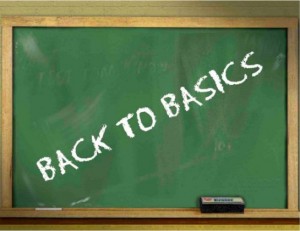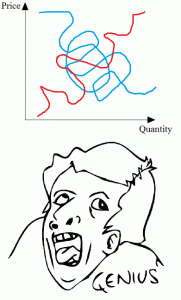Supply and Demand
The most basic of economic principles is that of supply and demand. Just about every economic argument comes down to how supply and demand are affected.
Supply refers to the goods that a producer is willing to part with at a given price, whereas demand refers to the willingness and ability for a buyer to purchase a particular good.
Supply is pretty self explanatory. If someone wants to part with a good or service at a certain price then that is the supply of that good. In many video games that feature shops, supply is seemingly unlimited (but not post-scarce!) as you can continuously buy the same item an infinite number of times, provided there are not inventory limits.
Demand can be a little more difficult to understand. Generally, demand requires for someone to have both the ability to pay for something and the desire to pay for it. So just because you can afford the first thing you see at Walmart, does not mean that you have demand for it. As a story device, RPGs often feature certain key items priced out of reach for the player in order to create an obstacle. Early on in Chrono Trigger, there’s a jerky salesman who is only willing to sell his product for 9900 gold, far beyond your holdings at that point in the game. Similarly, in Pokémon Red and Blue, the bicycle vendor is only willing to part with a bike for 1,000,000 Pokédollars (more than you could ever have at one time). Essentially, at these prices, there is no demand (assuming that every NPC has the same limitation) and so the goods remain unsold.
When supply and demand meet along their various curves, this is known as the price. The price, of course, is what you pay for all those goods and services that you enjoy. Generally, when supply increases and demand remains the same, price will drop. Likewise, when supply decreases and demand remains the same, the price will drop. The opposite is true with demand.
Where supply and demand meet perfectly, this is the “equilibrium price.” This only means that The demand is perfectly equal with supply, which pretty much never happens. It’s just a helpful thing to consider. When a good is at equilibrium price, it means that people are supplying goods at the same quantity as is demanded. This means that resources can better be used in other aspects of an economy. For example, buying the exact number of potions that you need leaves room for spending money on other items.
An important note is that just because supply is limited (or extremely low) doesn’t always mean that the price would be high. It must be in line with demand. There are countless examples of finding extremely rare loot (ancient swords, magical garments, special vials) in the deepest recesses of dungeons, only to take it to a local merchant and be offered a pittance. In Dragon Quest titles, it’s often 1 gold. Obviously, this offers a hint from the game developers to not sell that piece of loot because of its rarity. We can also call this a “price signal” which I will elaborate on in another article.
To sum up, in order to understand most economic concepts, you must first understand supply and demand. Supply refers to the availability of a good or service that someone is willing to trade. Demand refers to the willingness someone has to pay for something along with the ability to pay for it. Prices come from when these two concepts meet. When supply and demand are perfectly even, the result is equilibrium price. Ultimately, I think people would feel different about a lot of things if they understood how supply and demand factor into price.






